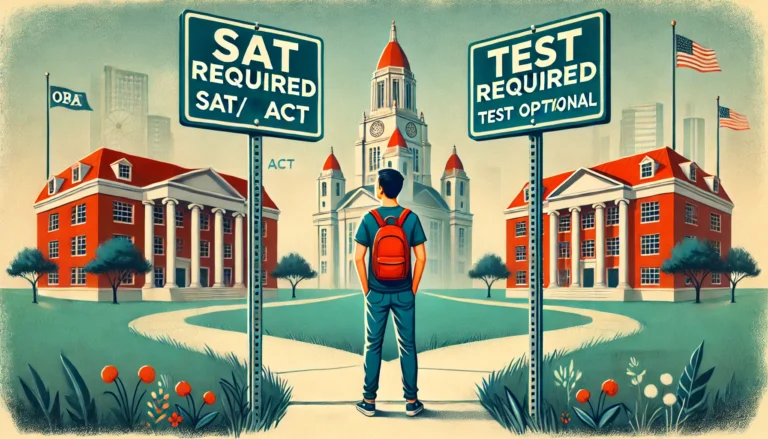The SAT, U.S. College Admissions, and the Changing Landscape of DEI Policies
By andyeunholee@gmail.com
March 19, 2025
– Trends in U.S. Higher Education Policy and Strategic Preparation –
The U.S. college admissions landscape has undergone continuous transformation over the years, with standardized testing and Diversity, Equity, and Inclusion (DEI) policies emerging as two of the most pivotal topics in recent discussions. As colleges adopt varying policies—such as Test-Optional or Test-Blind—these changes directly impact not only admissions practices but also equity in access to higher education.
Most recently, new guidelines issued by the U.S. Department of Education have highlighted potential legal concerns for institutions that overtly link testing policies to diversity initiatives. Consequently, these developments may significantly influence students’ application strategies. For parents planning their child’s higher education pathway in the U.S., it is essential to stay informed and responsive to such changes.
This article provides a comprehensive overview of the SAT, the reasons behind the growing adoption of Test-Optional policies, their intersection with DEI principles, and specific institutional case studies such as the University of California system.
1. Understanding the SAT: A Standardized Academic Assessment Tool
1) Origins and Purpose of the SAT
The SAT (originally the Scholastic Aptitude Test, now more commonly referred to as the Scholastic Assessment Test) was first introduced in the 1920s and 1930s as a benchmark to evaluate students’ readiness for college-level work. Over time, the SAT evolved into a key component in admissions decisions, serving as a standardized measure to compare students from varied academic backgrounds.
2) Role and Significance of the SAT
For decades, colleges have relied on SAT scores to assess:
- Academic ability: Through sections in Math, Reading, and Writing, the SAT provides insights into a student’s learning skills.
- Scholarship eligibility: Many scholarships—both institutional and external—consider SAT scores as part of their selection criteria.
- Comparative evaluation: Given the variability in grading standards across high schools, standardized tests have served as a common yardstick for evaluating applicants nationwide.
However, concerns have grown regarding the disparities in access to test preparation resources, leading to debates over the fairness of the SAT.
2. What is the Test-Optional Policy?
1) Definition and Characteristics
Test-Optional policies allow students to choose whether to submit standardized test scores without facing any penalty for omission. In such policies, the SAT becomes an optional component rather than a mandatory requirement.
2) Why Has Test-Optional Gained Momentum?
- Equity in Education:
Critics argue that the SAT favors students from higher-income backgrounds, as they are more likely to have access to private tutoring and preparatory courses. Test-Optional policies aim to level the playing field for under-resourced students. - Impact of COVID-19:
The pandemic led to widespread test center closures and exam cancellations, prompting institutions to adopt Test-Optional approaches to avoid disadvantaging applicants. - Broadening Applicant Pools and Increasing Diversity:
Studies indicate that Test-Optional policies have increased overall application numbers and enhanced opportunities for underrepresented students—including racial minorities, first-generation college-goers, and those from low-income backgrounds.
3. The Link Between DEI Policies and Testing Requirements
1) What is DEI (Diversity, Equity, Inclusion)?
- Diversity: Promoting a broad range of backgrounds, including race, socioeconomic status, gender, and more.
- Equity: Creating fair opportunities by addressing systemic barriers and providing appropriate support.
- Inclusion: Ensuring all students feel respected, valued, and fully integrated into the academic community.
2) How Test-Optional Policies Support DEI Goals
Many institutions view Test-Optional policies as a mechanism to enhance diversity and inclusion. Studies have shown a 10–12% increase in enrollment rates for underrepresented groups after implementing such policies. The underlying idea is that reducing reliance on test scores can help increase access for marginalized students.
4. New Federal Guidelines and Political Dynamics
1) The “Dear Colleague” Letter: Raising Concerns
A recent advisory letter issued during the Trump administration urged colleges to reassess race-based admissions practices, DEI programs, and scholarship criteria. Notably, it also questioned whether Test-Optional policies might serve as indirect proxies for race—potentially triggering legal challenges.
If colleges explicitly state that Test-Optional policies are designed to increase diversity, they may face accusations of reverse discrimination, thus exposing themselves to litigation risks.
2) Conservative vs. Progressive Views on DEI in Admissions
The current debate reflects broader ideological divides:
- Proponents of standardized testing: Argue that tests offer an objective and reliable way to assess student merit.
- Supporters of DEI and Test-Optional policies: Believe standardized exams reinforce socioeconomic disparities and hinder access for marginalized communities.
Harry Feder of FairTest also notes that the SAT has historically contained racial biases, prompting a reevaluation of its role in fair admissions.
5. The University of California System: A Case Study
1) Implementation of Test-Blind Admissions
The UC system currently adopts a Test-Blind policy, meaning submitted SAT scores are not considered in admissions decisions at all. This was designed to promote fairness and boost diversity across the system’s campuses.
2) Ongoing Internal Debate: Should Testing Return?
UC’s internal academic committees are actively debating whether to reinstate standardized testing due to concerns over grade inflation in high school GPAs and the resulting difficulty in assessing academic readiness.
- UC Berkeley and UCLA: Advocate for reintroducing tests to enable more accurate academic evaluation.
- UC Santa Cruz: Warns that reintroducing tests may deter applications from low-income students and harm diversity.
Ultimately, decisions rest with the UC Board of Regents, which has previously rejected proposals to reinstate testing.
6. Practical Recommendations for Parents
- Closely monitor individual college policies: Test-Optional or Test-Blind policies are subject to change due to political and social dynamics. Stay informed about your target schools.
- Continue preparing for the SAT: Regardless of institutional policies, strong SAT scores can still benefit students in admissions and scholarships.
- Build a comprehensive application profile: Focus on academic rigor, GPA, extracurricular activities, and leadership experiences to strengthen your child’s overall candidacy.
- Effectively present your personal background and strengths: Use personal statements and activity descriptions to highlight unique experiences, goals, and values.
- Explore financial aid and scholarships: Many universities offer generous aid packages, and SAT scores may still be considered for merit-based scholarships.
7. Conclusion: A Multi-Dimensional and Flexible Approach is Key
In today’s complex college admissions environment, test policies are more than just procedural details—they are deeply intertwined with institutional values, political pressures, and broader societal challenges.
- Advocates of standardized testing emphasize objectivity and merit.
- Opponents highlight the need for equitable opportunities, particularly for disadvantaged students.
What matters most is for parents to stay well-informed and help their children navigate these shifting dynamics with a balanced and strategic approach. A strong SAT score, coupled with academic excellence and meaningful activities, remains one of the most effective paths toward successful college admission.
Given the pace of change in higher education policy, we strongly recommend maintaining regular awareness of admissions trends and consulting with experienced professionals when needed. We are committed to continuously monitoring these developments and sharing valuable insights with families.
Thank you.
Andy Lee
Elite Prep Suwanee
1291 Old Peachtree Rd, NW #127
Suwanee, GA 30024
Website: eliteprep.com/suwanee
Email: andy.lee@eliteprep.com
1:1 Educational Consulting (Online/In-Person): Consultation Request Form





![SAT Registration for 2025–2026 Is Now Open!]](https://elite4usa.com/wp-content/uploads/2025/05/05292025-1-768x430.png)

